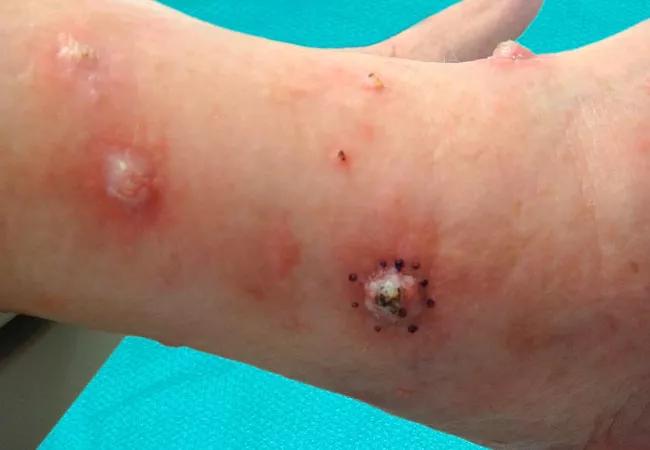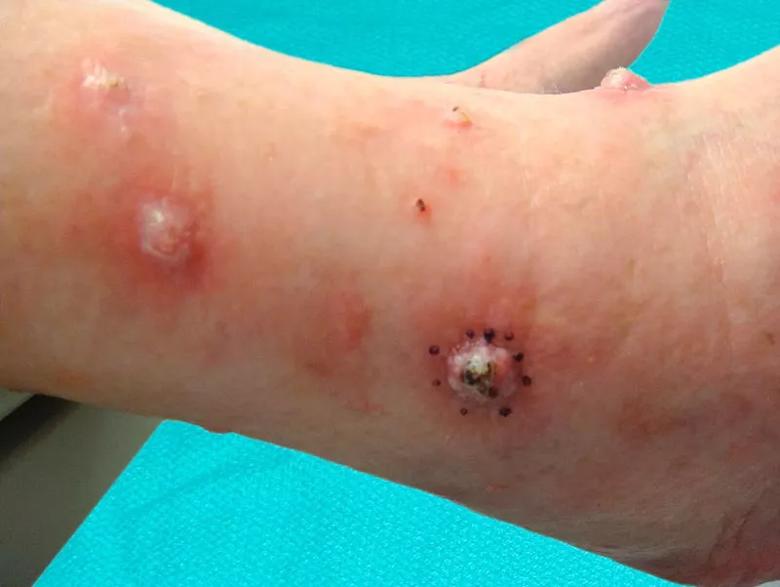Side effects and management strategies

by Anthony Fernadez, MD, and Christie Warren, MD
Cleveland Clinic is a non-profit academic medical center. Advertising on our site helps support our mission. We do not endorse non-Cleveland Clinic products or services. Policy
Note: This is an abridged version of an article originally published in the Cleveland Clinic Journal of Medicine.
Biologic therapies have revolutionized medicine and offer targeted therapy for an increasing number of diseases, particularly in rheumatology, gastroenterology, hematology/oncology and dermatology. But along with these advances and their ensuing expanded use have come many unique adverse effects.
Some of the most commonly reported adverse effects with these new therapies are cutaneous, and can potentially limit the use of these agents and add cost to already expensive treatment regimens.1
It is important for physicians and other healthcare providers to be aware of these effects, have a basic understanding of how to manage patients with these reactions, and to know when to refer to a dermatologist. This is the third in a series of four articles that review recent literature on cutaneous adverse reactions experienced with commonly prescribed biologic and targeted therapies, specifically small-molecule tyrosine kinase inhibitors (TKIs).
TKIs block intracellular signaling pathways that regulate cellular functions, such as proliferation and differentiation in tumor cells. Different small molecules may target different components of the tyrosine kinase signaling cascade. Examples include imatinib, dasatinib, nilotinib, ponatinib, bosutinib, sorafenib, sunitinib, pazopanib, axitinib, vandetanib, dovitinib, vemurafenib, dabrafenib and ruxolitinib.

Imatinib is commonly used to treat Philadelphia-chromosome-positive chronic myelogenous leukemia (Ph+CML) and gastrointestinal stromal tumors. It can trigger skin eruptions, sometimes in up to 20% of treated patients. A study of 532 patients with chronic-phase CML treated with imatinib daily found that 32% reported a rash or related cutaneous event.20 Most commonly, the rash presented as an exanthematous papular eruption.
When mild, this rash will resolve spontaneously. However, more severe skin eruptions may require stopping treatment for two weeks, and then restarting at a lower dose. Upon reintroduction, a potential strategy is to temporarily add an oral corticosteroid to minimize risk of a repeat cutaneous reaction.
Beyond rash, one prospective study of 54 patients on imatinib found that 7% developed photosensitivity and 7% developed a psoriasiform eruption.21 Imatinib has also been linked to Stevens-Johnson syndrome, acute generalized exanthematous pustulosis, and Sweet syndrome (acute febrile neutrophilic dermatosis). Discontinuation is recommended in these cases. For the latter two, the decision to attempt retreatment depends on the extent of the reaction and if there are therapeutic alternatives.
Dasatinib, nilotinib, ponatinib, and bosutinib are second-generation TKIs that are used for treatment of Ph+CML. There are a number of cutaneous findings to be aware of when encountering these drugs.
Phase 1 and 2 studies of dasatinib found that of 911 patients, 35% had cutaneous eruptions, including localized and generalized erythema, papular eruptions, and pruritus.22
In phase 1 and 2 studies of nilotinib, 20% to 28% suffered a nonspecific rash, 15% to 24% had pruritus, and 12% had dry skin.23
Bosutinib can cause adverse dermatologic concerns in 20% to 44% of patients, including erythema, maculopapular eruption, pruritic rash, allergic dermatitis, acne, folliculitis and skin exfoliation.24
Treatments for the above reactions generally include topical and systemic corticosteroids, isotretinoin and oral H1 antihistamines, depending on the specific concern.
Sorafenib and sunitinib are multitargeted TKIs whose most common cutaneous effects involve hand-foot skin reactions. A metaanalysis involving 6,011 patients on sorafenib found hand-foot skin reactions occurred in 39%, while less common cutaneous reactions included all-grade rash or desquamation (35.4%), alopecia (25.5%), pruritus (14%), and dry skin (14.1%).25 Patients treated with sunitinib or sorafenib who develop handfoot skin reactions tend to develop localized tender lesions in friction areas that can become blistered or hyperkeratotic. Handfoot skin reactions appear more commonly with sorafenib than with sunitinib, and their severity with higher doses is a pattern found specifically in sorafenib recipients.26 For mild hand-foot skin reactions, dosing of the medication can remain the same, and topical emollients, topical urea, or salicylic acid may be effective. In more severe cases, treatment may require a topical corticosteroid or temporary reduction in dose.
Sorafenib has also been associated with cutaneous squamoproliferative lesions such as keratoacanthomas and squamous cell carcinomas.27 Of note, lesions have the potential to regress upon cessation of therapy. Complete surgical excision, similar to treatment of those not on the drug, can be employed in these cases.
Pazopanib, axitinib, vandetanib, and dovitinib are all multitargeted TKIs. Pazopanib is used for advanced renal cell carcinoma and soft-tissue sarcoma. When studied in 290 patients with renal cell carcinoma, changes in hair color occurred in 38% of recipients.28
Axitinib is approved for the treatment of advanced renal cell carcinoma. Of 984 patients, 29.2% had hand-foot skin reactions.29 Vandetanib is used for patients with medullary thyroid cancer and lung cancer. It can present with skin reactions of dermatitis, acneiform eruption, dry skin, pruritus, photosensitivity, or hand-foot skin reactions in 28% to 71% of 30 patients.30
Dovitinib is used in renal cell carcinoma and melanoma. It has been reported to cause acneiform eruptions and eruptive facial milia and comedones.31

Acneiform eruption in patient receiving dovitinib for glioblastoma.
Topical antiseptics, topical antibiotics, oral antibiotics and systemic isotretinoin can be used for treatment. A short course of a low-dose systemic corticosteroid can also be useful to control inflammation.31
Vemurafenib and dabrafenib are inhibitors of the kinase domain in mutant BRAF (a serine-threonine kinase) and are used for treatment of metastatic melanoma with a V600E BRAF mutation. In clinical trials in 675 patients, vemurafenib was associated with a rash in 18% of patients, photosensitivity in 12%, squamous cell carcinoma or keratoacanthoma in 18% to 26%, and alopecia in 8%.32 Dabrafenib also has been associated with development of keratoacanthomas or well-differentiated cutaneous squamous cell carcinoma in 6% to 26% of patients.33 Treatment of these skin lesions can include phototherapy, intralesional methotrexate, retinoids or surgical excision.
Ruxolitinib is a Janus-associated kinase inhibitor used in the treatment of myelofibrosis and polycythemia vera. Ruxolitinib is particularly associated with the development of skin cancer, as 17.1% of patients on the therapy developed basal cell carcinoma or squamous cell carcinoma compared with 2.7% of patients on alternate available therapy for myelofibrosis.34 A case series reported 5 patients with a history of myelofibrosis treated with ruxolitinib who developed multiple skin cancers with aggressive features, including a lentigo maligna melanoma.34

Eruptive squamous cell carcinoma keratoacanthomas in a patient receiving ruxolitnib for primary myelofibrosis.

An underdiagnosed condition in patients with cancer

Study demonstrates superior visualization of occult primary lesions

New device offers greater tumor control for malignant liver lesions

Cleveland Clinic researchers discover what drives – and what may halt – virus-induced cancer

First-ever U.S. population-level retrospective analysis reveals many patients with systemic mastocytosis need faster intervention

New program provides prehabilitation and rehabilitation services to help patients with cancer maintain and regain function

First-of-its-kind research investigates the viability of standard screening to reduce the burden of late-stage cancer diagnoses

Global R&D efforts expanding first-line and relapse therapy options for patients